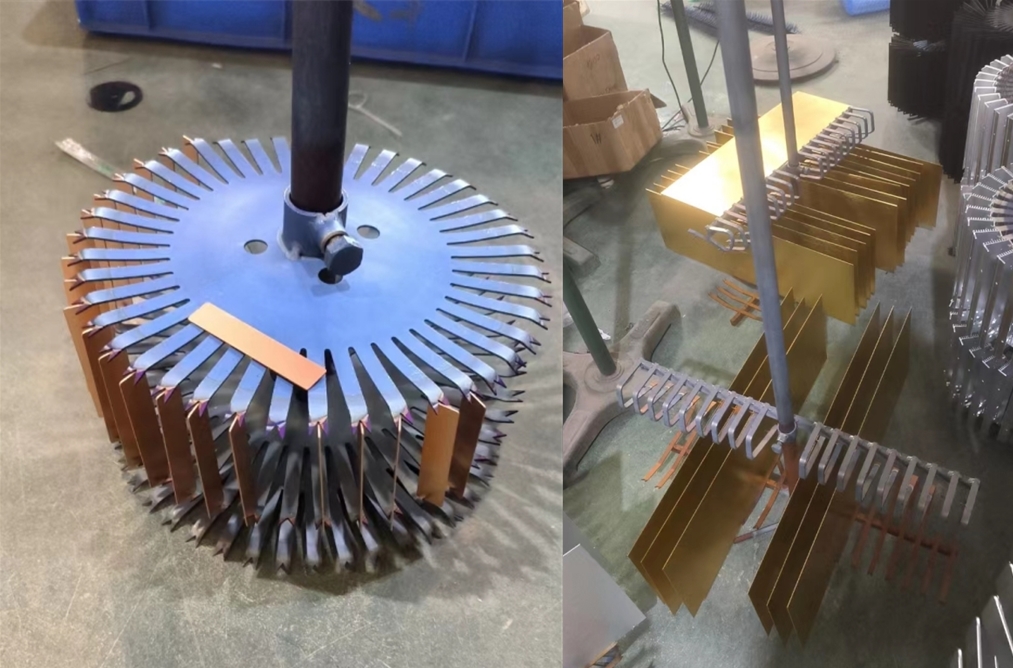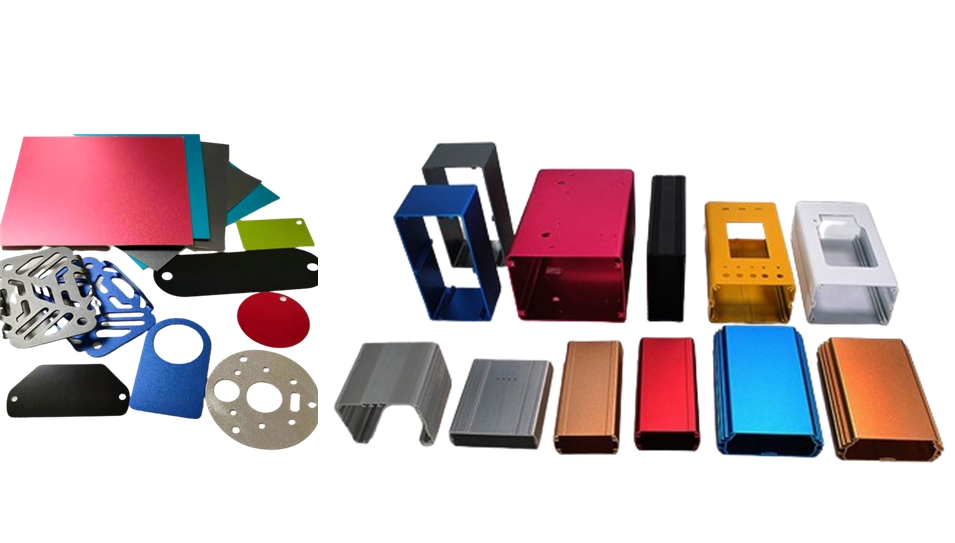Anodized aluminum is a type of aluminum that has undergone an electrochemical process called anodization. This process involves immersing the aluminum in an electrolytic solution and passing an electric current through it. The result is the formation of a layer of oxide on the surface of the aluminum.
During anodization, the aluminum acts as the anode (positive electrode) in an electrolytic cell. The aluminum surface is first cleaned and then subjected to the electrolytic process, typically using sulfuric acid as the electrolyte. The electric current causes the formation of an oxide layer, which is hard, durable, and corrosion-resistant.

The anodized layer on aluminum can vary in thickness, and it can also be dyed to achieve different colors. This process not only enhances the corrosion resistance of aluminum but also provides a decorative finish. Anodized aluminum is commonly used in a variety of applications, including architectural elements, consumer electronics, automotive parts, and outdoor furniture, among others. The resulting surface is often smoother and more resistant to wear than untreated aluminum.
FAQs About Anodized Aluminum
1. What is the purpose of anodizing aluminum?
Anodizing aluminum serves several purposes, including enhancing corrosion resistance, providing a decorative finish, improving surface hardness, and offering better adhesion for paint and other coatings.
2. Can anodized aluminum be colored?
Yes, the anodized aluminum can be colored. The anodizing process allows for the introduction of pigments into the oxide layer, creating a wide range of colors. This makes anodized aluminum popular for decorative and aesthetic purposes.
3. What colors are available for anodized aluminum?
Anodized aluminum can be produced in a variety of colors, offering a versatile and decorative finish. The color options are achieved by introducing pigments into the oxide layer during the anodization process. The actual colors available may vary depending on the specific anodizing process and the manufacturer. Some common anodized aluminum colors include natural (silver/gray), black, gold, red, blue, green, purple, bronze, copper, and custom colors. The specific colors depend on the pigments introduced during the anodization process.
4. What are the key benefits of anodized aluminum?
Corrosion Resistance: Anodizing significantly enhances the corrosion resistance of aluminum. The anodized layer acts as a protective barrier, making the material more resistant to environmental factors.
Surface Hardness: Anodized aluminum has increased surface hardness compared to untreated aluminum. This makes it more resistant to scratches and wear.
Decorative Finishes: Anodizing allows for a variety of colors and finishes, providing aesthetic options for designers and manufacturers.
Durability: The anodized layer is chemically stable and adheres strongly to the aluminum surface, resulting in a durable finish that is less prone to chipping or peeling.
Temperature Resistance: Anodized aluminum can withstand a range of temperatures, making it suitable for both indoor and outdoor applications.
5. Is anodized aluminum better than aluminum?
Whether anodized aluminum is “better” than untreated aluminum depends on the specific requirements of the application. Anodized aluminum offers certain advantages over untreated aluminum in certain contexts, but it also has some limitations. Anodized aluminum is generally more expensive than untreated aluminum due to the additional processing involved in the anodization process.
6. Where is anodized aluminum commonly used?
- Architectural Applications: Anodized aluminum is often chosen for architectural elements, such as window frames, facades, and decorative features, due to its corrosion resistance and aesthetic versatility.
- Consumer Electronics: Anodized aluminum is commonly used in the manufacturing of smartphones, laptops, and other consumer electronics for its scratch resistance and sleek appearance.
- Outdoor Furniture: Its resistance to environmental factors makes anodized aluminum suitable for outdoor furniture, where it can withstand exposure to sunlight and moisture.
- Aerospace and Automotive: Anodized aluminum is used in aerospace and automotive industries for its combination of corrosion resistance, lightweight properties, and decorative options.
7. Is anodized aluminum environmentally friendly?
Anodizing is generally considered an environmentally friendly process. The resulting oxide layer is chemically stable and does not easily leach into the environment. Additionally, the anodizing process itself generates fewer waste byproducts compared to some other surface finishing methods.
8. Can anodized aluminum be recycled?
Yes, anodized aluminum is recyclable. The anodization process does not affect the recyclability of aluminum, and recycling helps conserve resources and reduce environmental impact.
9. How long will anodized aluminum last?
The longevity of anodized aluminum depends on various factors, including the quality of the anodizing process, the thickness of the anodized layer, environmental conditions, and the specific application. Usually, it can last 10-20 years.
10. Will the anodized aluminum color fade or tarnish?
While anodized aluminum is highly resistant to color fading or tarnishing, it’s important to note that no material is entirely immune to changes over time, especially when subjected to challenging conditions. The changes, if any, are usually gradual, and anodized aluminum is known for maintaining its appearance well over the years.
11. What factors will influence the anodized process?
Several factors can influence the anodizing process, affecting the quality, appearance, and performance of the anodized aluminum. These factors range from the characteristics of the aluminum substrate to the specifics of the anodizing process. Here are 10 key factors that can influence the anodizing process:
- Aluminum Alloy: The specific alloy of aluminum used can impact the anodizing process. Different alloys have varying responses to anodization, affecting the thickness and characteristics of the anodized layer.
- Surface Preparation: Proper cleaning and pretreatment of the aluminum surface are essential for successful anodizing. Any contaminants, oils, or residues on the surface can interfere with the formation of a uniform anodized layer.
- Chemical Composition of Electrolyte: The electrolyte solution used in the anodizing bath, often sulfuric acid, can be adjusted in terms of concentration and temperature. Variations in the chemical composition can influence the growth rate and characteristics of the anodized layer.
- Anodizing Voltage and Current Density: The anodizing voltage applied and the current density play a crucial role in determining the thickness and properties of the anodized layer. Precise control of these parameters is necessary for achieving desired results.
- Anodizing Time: The duration of the anodizing process affects the thickness of the oxide layer. Longer anodizing times result in thicker layers, but excessive times may lead to undesirable effects.
- Sealing Process: After anodization, a sealing process is often employed to close the pores of the anodized layer. The sealing method, whether hot water sealing, steam sealing, or other techniques, can impact the corrosion resistance and color stability.
- Dyeing or Coloring Agents: If the anodized aluminum is intended to have a colored finish, dyeing or coloring agents are introduced during or after the anodizing process. The type and concentration of these agents influence the final color.
- Temperature Control: Maintaining precise temperature control in the anodizing bath is crucial for consistent results. Temperature variations can affect the rate of oxide layer formation.
- Racking and Fixturing: The way aluminum parts are positioned and suspended in the anodizing bath can influence the evenness of the anodized coating. Proper racking and fixturing are essential for uniform results.
- Post-Anodizing Treatments: Some applications may involve additional treatments after anodizing, such as laser marking, polishing, or surface etching. These treatments can impact the final appearance and characteristics of the anodized aluminum.
12. Which is stronger stainless steel or anodized aluminum?
The strength of stainless steel and anodized aluminum depends on various factors, such as the specific alloy and the manufacturing process. In general, stainless steel is often considered to be stronger than anodized aluminum.
It’s essential to consider the specific application and requirements when choosing between stainless steel and anodized aluminum. Stainless steel is often preferred in applications where higher strength, corrosion resistance, and durability are critical, such as in structural components, kitchen appliances, and industrial equipment. Anodized aluminum, with its lighter weight and corrosion resistance, is commonly used in applications like consumer electronics, architectural elements, and certain aerospace components.
13. Does anodizing stop rust?
Yes, anodizing provides effective corrosion resistance and helps prevent rust on aluminum surfaces. The anodization process involves the formation of a thick and protective oxide layer on the surface of the aluminum. This oxide layer acts as a barrier, creating a physical and chemical shield that significantly enhances the corrosion resistance of the metal.
14. Can anodized aluminum be re-anodized?
It is generally not practical to re-anodize aluminum once the initial anodized layer is formed. Re-anodizing involves stripping the existing layer, which may alter the dimensions of the aluminum and is often not cost-effective.
15. How does anodized aluminum differ from regular aluminum in terms of appearance?
Color Options: Regular aluminum typically has a natural metallic appearance, while anodized aluminum offers a broader spectrum of color options. Anodizing allows for the introduction of various colors, including standard shades like black, bronze, and clear, as well as custom hues.
Non-Reflective Surface: Anodized aluminum often has a non-reflective surface, reducing glare and reflections. This property can be advantageous in various applications, especially those where visual clarity is crucial.
16. Can anodized aluminum be engraved or laser-marked?
Yes, anodized aluminum is well-suited for engraving or laser marking. The anodization process creates a durable and relatively hard surface layer on the aluminum, making it suitable for various marking methods without compromising the integrity of the material.
Engraving on anodized aluminum can be achieved through mechanical methods, such as rotary engraving or CNC milling, which remove the anodized layer to reveal the bare metal underneath. Laser marking, on the other hand, utilizes a laser beam to selectively remove or alter the anodized layer, creating high-contrast and precise markings.
The contrast in color between the anodized surface and the bare metal beneath allows for the creation of detailed and legible markings, making anodized aluminum a popular choice for applications where permanent and visible labeling is required. This makes it valuable in industries such as signage, industrial labeling, and product branding.
Additionally, the anodized layer provides good adhesion for inks and dyes, allowing for color-filled engraving or marking if desired. This versatility makes anodized aluminum a preferred material for applications where customization, branding, or information labeling is essential.
17. What is the typical thickness of the anodized layer on aluminum?
The thickness of the anodized layer on aluminum can vary depending on the specific application and requirements. However, the typical range for the thickness of an anodized layer is around 0.0002 to 0.001 inches or approximately 5 to 25 micrometers.
18. Is anodized aluminum saltwater resistance?
Yes, anodized aluminum is known for its excellent resistance to saltwater corrosion.
Anodized aluminum is commonly used in marine applications where exposure to saltwater is a constant factor. Marine hardware, boat components, and structures near coastal areas are often made from anodized aluminum due to its ability to withstand the corrosive effects of saltwater.
19. How do you clean and maintain anodized aluminum?
Anodized aluminum is relatively low-maintenance. Cleaning with a mild detergent and water is usually sufficient. Avoid abrasive cleaners or materials that could scratch the anodized surface. Regular cleaning helps maintain the appearance over time.
20. Is anodized aluminum more expensive than untreated aluminum?
The cost of anodized aluminum is typically higher than untreated aluminum due to the additional processing involved. However, the enhanced properties and aesthetic benefits may justify the higher cost for certain applications.
As a customer-centric company, we prioritize not only the quality of our products but also the satisfaction of our clients. Whether you require customized components for architectural applications, aerospace, or consumer goods, our factory is equipped to deliver solutions that exceed expectations.


